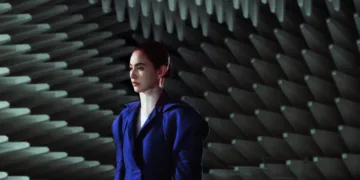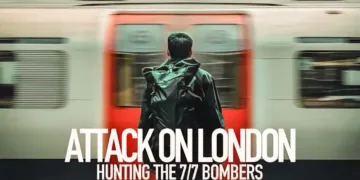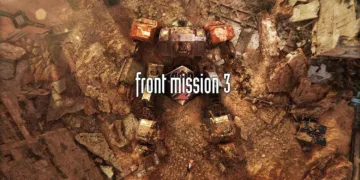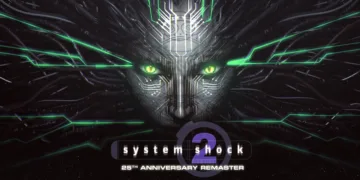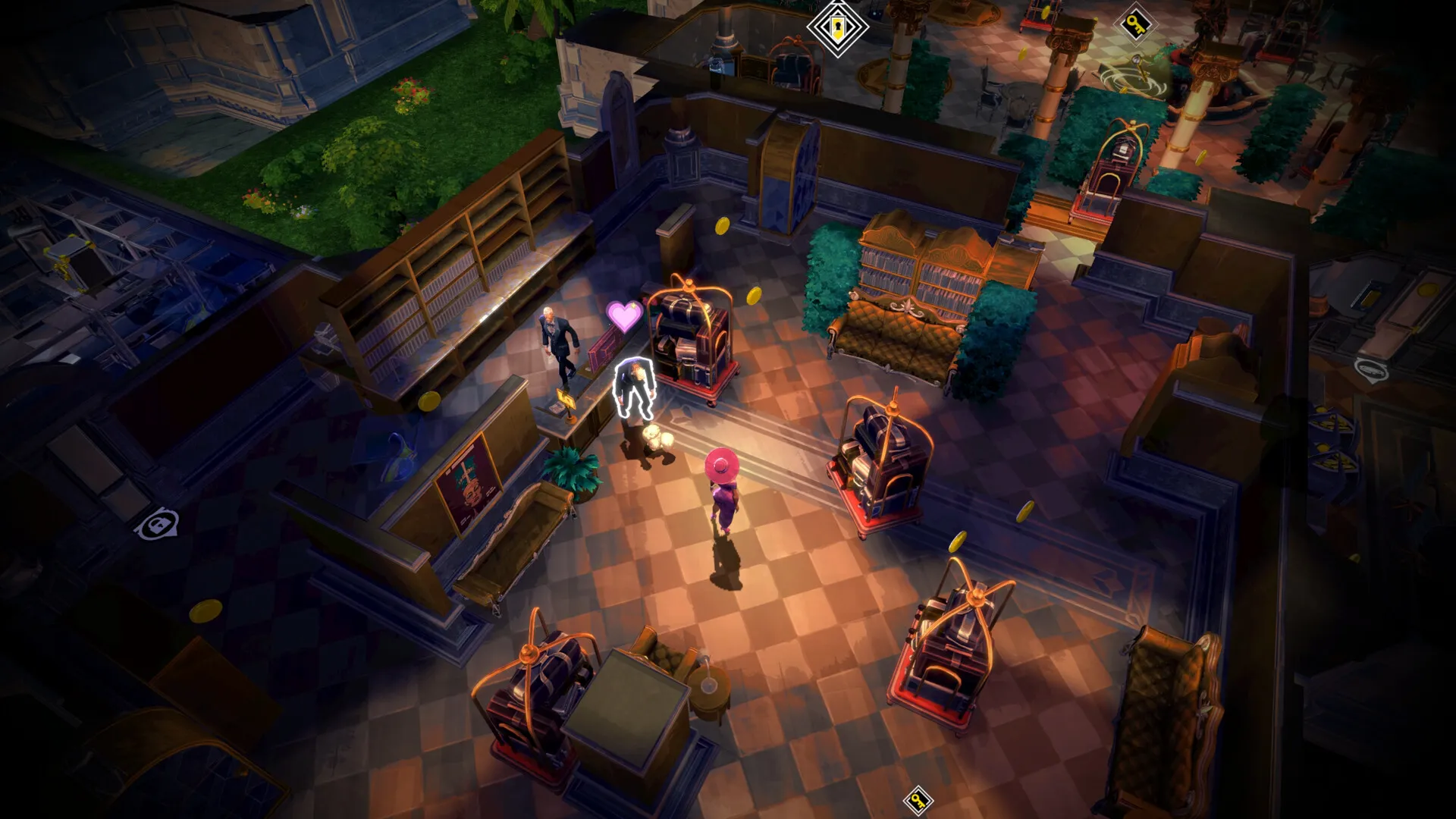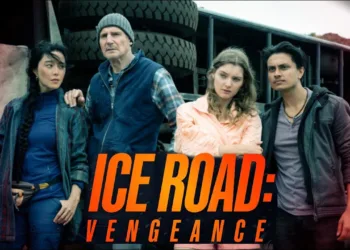Monaco 2 throws you into a desperate gambit: a quartet of amateur thieves coerced by a ruthless crime lord after a botched caper. From the outset, pacing balances careful planning with the thrill of emergent chaos. Early missions introduce a freely rotatable isometric camera, granting a tactical viewpoint on patrol routes and blind corners. This tool transforms each level into a dynamic stage for improvisation—no longer confined to a fixed bird’s-eye frame, you can zoom in for intimate corridors or pull back for a broad sense of your escape routes.
Character roles mirror narrative stakes. The hacker’s drone drifts through vents to silence alarms, heightening tension when every second counts. The socialite’s Pomeranian distracts guards, creating moments of levity amidst the suspense. When the brute charges through locked doors, you feel the weight of desperation rising in sync with pounding footsteps. These mechanics interweave with the story’s push-and-pull: resource gathering fuels both tangible upgrades—smoke bombs, lockpicks—and emotional investment in each heist’s outcome.
Collectible diamonds unlock trinkets and costumes, rewarding both speed and stealth. Procedural remix modes like Unreliable Narrator cast familiar maps in new patterns, ensuring the narrative pulse never dulls. Solo play offers tight control over each thief, but the game’s true resonance appears in cooperative sessions, where planning discussions echo the very dialogues you witness in cut-scenes—proof that Monaco 2 treats gameplay as storytelling in motion.
Crafting the Perfect Caper: Goals, Gear, and Grit
Monaco 2’s heists center on crystalline objectives: snatch the target and slip away before alarms crescendo. Early levels teach you two distinct rhythms—“Smash and Grab” demands a lightning sprint past startled guards, whereas “Clean Getaway” invites careful mapping of patrol paths.
Secondary tasks—snagging every scattered coin or evading detection entirely—layer in tension, rewarding those who balance speed with stealth. This structure echoes the tight mission design of indie stealth gems like Mark of the Ninja, yet Monaco 2 adds narrative weight: each successful extraction inches you closer to freedom from the crime boss’s chokehold.
Roles feel woven into the story’s arc. Gibson’s drone isn’t a gimmick—it represents the crew’s reliance on technology when brute force would draw unwanted heat. Cosmo and Gimlet’s diversionary flourish captures the emotional high of outsmarting an enemy, transforming a simple distraction into a moment of playful triumph.
Sake’s parkour flits between cover and skylight, mirroring her character’s desperate determination to stay one step ahead. Una’s raw strength delivers catharsis when a locked vault door stands between you and redemption. Meanwhile, Pockets or Jobbie provide brief respites—healing, speed boosts or simultaneous hacks—that feel like story beats granting the team room to breathe before the next crescendo.
Resources fuel both mechanics and mood. Coins littered through each map let you purchase smoke bombs, lockpicks or health kits, reminding you that every choice carries weight. Diamonds—earned through speed, secrecy or scavenging—unlock trinkets that tweak special abilities or grant cosmetic flair.
This economy mirrors the narrative tension of scraping together enough leverage to satisfy a ruthless overlord. The three-life system, with its respawn-at-death-site safety net, keeps frustration at bay without hollowing out the stakes; losing a life feels significant, yet each recovery underscores your crew’s resilience.
Polish in design keeps focus on momentum. The blueprint overview exposed at mission start lets you chart routes with narrative intent—do you bypass the gallery of priceless art or risk detours for extra coins? Mid-mission checkpoints permit on-the-fly character swaps and trinket adjustments, offering tactical pivots that feel like rewriting your own story. Finally, camera controls—rotation, zoom and view toggles—grant perspective on both looming threats and hidden opportunities, ensuring the emotional rhythm never stalls.
Framing the Heist—Space, Sightlines and Replay
The shift to a freely rotatable isometric camera transforms each map into a living storyboard. Spinning the view a full 360° uncovers hidden patrol routes and blind spots that lurk behind pillars or below mezzanine edges. Zooming in exposes cracked floorboards and pressure plates; zooming out reveals the broad sweep of escape routes snaking across a yacht’s deck or through a hotel lobby.
When walls fade as you pivot the camera, a sudden reveal of an unseen guard can jolt the senses—an effect reminiscent of cinematic stealth moments in indie gems like Mark of the Ninja, where seeing and being seen play emotional tag.
Environments range from sunlit deckchairs on a luxury yacht to the opulent chaos of a crowded opera house foyer. Tight corridors on a prison transport ship ratchet up claustrophobia, while an open-air shipyard invites daring splits of your crew. Each locale introduces themed hazards—lasers humming across vault doors, security cameras sweeping lobbies, pressure pads triggering deadly traps—that feel scripted for maximum suspense. In quieter hallways, the faint echo of distant footsteps can stir anticipation as keenly as a filmic score.
Visually, Monaco 2 sheds its pixel roots in favor of low-poly models bathed in stylized palettes. Character silhouettes read like shadow puppets, each thief instantly identifiable by shape and hue. Spotlights carve silhouettes across stained-marble floors, while clouds of smoke swirl through key choke points, giving stealth attempts a dramatic flair. Dynamic shadows lend weight to every step, and flickering neon signs in a casino map pulse like an anxious heartbeat.
Procedural remix modes ensure these crafted stages never grow stale. Unreliable Narrator shuffles guard routines, camera angles and even furniture placement, prompting fresh strategies on familiar ground. Daily Heists lock in layouts for a 24-hour gauntlet, stoking friendly rivalry via leaderboards and diamond rewards. Cosmetic unlocks tie progression to performance, rewarding players who embrace both nimble evasion and full-tilt rushes. Such features turn each map into a palimpsest of rehearsed plans and last-second improvisations—proof that a well-designed stage can keep its secrets long after opening night.
Crafting the Crew—Abilities, Upgrades, and Narrative Momentum
Monaco 2’s eight-piece thief roster feels like a storyboard come to life. Four figures step into each mission, their unlocks tied to narrative beats: finish the jewel heist to earn the safecracker, clear the opera sabotage for the agile climber. For completionists, diamonds let you recruit optional specialists whose backstories add fresh stakes—each new face a reminder of the crew’s growing desperation under the crime lord’s thumb.
Progression branches into level-based skill trees. Gibson’s drone gains speed and range, echoing his rising confidence as the team tackles bolder scores. Cosmo’s Pomeranian unlocks trinkets that boost distraction radius or even fetch coins automatically, turning a simple diversion into a character-driven moment of charm. A six-slot trinket tray per thief lets you stack modifiers—one playthrough you might arm Una with a burst shield trinket, the next you swap for a sprint boost—crafting strategies that feel as personal as a film director choosing camera lenses.
The in-mission shop reinforces emotional tension. Coins scattered in vault corners force split-second decisions: buy a smoke bomb now to save a teammate, or hoard for lockpicks that unlock narrative-critical doors later? Diamonds, awarded for stealth runs or speed records, unlock costumes that feel like earned trophies rather than mere vanity. This mirrors how indie titles like Celeste reward skill mastery with story snippets—Monaco 2 weaves progression into both gameplay and plot.
Milestone unlocks broaden the stage. Completing chapter three opens the Unreliable Narrator mode, its random layouts echoing the crew’s unraveling trust. Finishing the campaign grants daily heists, tempting dedicated fans to chase ever-shifting challenges. These layers ensure Monaco 2’s world feels alive—even after the credits roll, the story keeps unfolding in every new run.
Scoring Suspense—Music, Voices and Environmental Cues
Monaco 2’s soundtrack channels the smoky lounges of classic caper films. Smooth jazz melodies ripple beneath your heist, then snap into staccato bursts when alarms blare. In certain maps you’ll spot a live trio tucked into a balcony or dockside cabana; their instruments continue playing as guards swarm, creating a surreal contrast between crash cymbals and cascading alarms. This musical pacing heightens moments of calm—where each muted brush of drums feels like a lull before you dash for cover—and moments of crisis, where an escalating saxophone line triggers adrenaline.
Voice work deepens immersion. Guards murmur in French, German or Italian dialects as they patrol, lending each locale a lived-in quality. Thieves toss out wry one-liners when downing a med-kit or hacking a console, reinforcing their personalities through tone and timing. Even background NPC chatter—snippets about gala preparations or murmured gossip—paints a vivid soundscape that feels richer than any silent stealth title.
Ambient effects tie audio to action. Footsteps echo differently on marble floors versus wooden planks, warning you of nearby patrols if you listen closely. Thermal camera hums and drone whirs signal approaching danger, while UI beeps alert you to low health or spent abilities. These layered cues guide decisions as much as any on-screen prompt—reminding us that in a true heist, hearing can be as vital as sight.
Lone Wolf or Crew Command—Modes and Accessibility
Monaco 2 offers two distinct rhythms: a solo campaign where you juggle four thieves via a quick-switch wheel, and a cooperative ballet for up to four players. In single-player, AI teammates follow predetermined routes with varying reliability. Moments of triumph—when a drone slices through lasers just as guards round a corner—can give way to frustration if an AI missteps. Checkpoint-based character swaps soften that blow, letting you pivot strategies mid-mission rather than restarting an entire level.
Local split-screen and online sessions introduce a different energy. Room filters help you match campaign progress or desired challenge, while synchronous gadget use—one player hacking cameras as another lays down smoke—creates emergent story beats that feel pulled from ensemble heist films like A Way Out. Revives and shared currencies tie each player’s survival to the team’s emotional stakes: a successful extraction feels far richer when it’s earned together.
Monaco 2’s guard reaction windows and smoke-bomb distraction times strike a considerate balance between tension and forgiveness. Multiple lives and the ability to reclaim dropped loot ease the sting of failure, especially in sprawling maps where a lone player may spend double the time of a full crew. This elasticity in difficulty echoes underappreciated indie titles like Katana ZERO, where a safety net empowers experimentation without emptying the well of suspense.
Controls and UI keep pace with varied playstyles. Fully remappable inputs on console and PC ensure comfort, while on-screen prompts clarify interactable objects during heated moments. Adjustable camera sensitivity and dead-zone settings accommodate newcomers and veterans alike.
Accessibility options further broaden appeal: colorblind modes tint guard vision cones, subtitles and scalable text assist with narrative immersion, and toggles for extra lives or gentler guard awareness make each heist approachable.
Leaderboards for quickest runs, stealth scores and weekly challenges feed habit-forming replay. Cosmetic unlocks tie performance to personalization, letting you flaunt achievements as loudly as a getaway siren. In choosing between solo mastery and cooperative chaos, Monaco 2 poses a subtle question: does a heist tell its best story in whispered solos or in voices harmonizing across the radio?
The Review
Monaco 2
Monaco 2 refines its predecessor’s charm into a sleek, strategic heist game. The upgraded visuals, fluid camera controls, and nuanced progression system elevate each mission’s stakes, while coop moments bring out genuine teamwork thrills. Occasional solo pacing issues linger, but generous accessibility options and rhythmic audio keep momentum strong.
PROS
- Engaging co-op synergy keeps every raid fresh
- Flexible camera controls enhance tactical planning
- Rich, jazz-infused soundtrack heightens suspense
- Diverse character abilities encourage varied playstyles
- Procedural remix modes extend replay value
CONS
- Solo runs can feel drawn-out on sprawling maps
- AI teammates sometimes miss critical cues
- Randomized layouts can stall mission momentum
- Story elements feel light outside core objectives




















